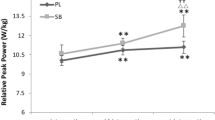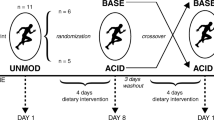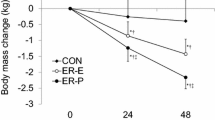Abstract
The aim of this study was to evaluate the effect of magnesium (Mg) loading (10.0 mg Mg/kg body wt) and daily Mg supplements (5.0 mg Mg/kg body wt) on Mg deficiency shown by increased and not by decreased serum Mg concentration during hypokinesia (decreased km number/d).
The studies were done during 30 d of prehypokinesia and 364 d of hypokinesia (HK) periods. Forty endurance-trained volunteers aged 22–26 yr with a peak VO2 max of 66.3 mL·kg−1 min−1 and with an average 15.0 km/d running distance were chose as subjects. They were equally divided into four groups:
-
1.
Unsupplemented ambulatory control subjects (UACS).
-
2.
Unsupplemented hypokinetic subjects (UHKS).
-
3.
Supplemented hypokinetic subjects (SHKS).
-
4.
Supplemented ambulatory control subjects (SACS).
The SHKS and SACS groups took daily 5.0 mg elemental Mg/kg body wt and subjected to Mg loading (10.0 mg Mg/kg body wt). Both the SHKS and UHKS groups were maintained under an average running distance of 4.7 km/d, whereas the SACS and UACS groups did not experience any modifications to their normal training routines and diets.
During the prehypokinetic and hypokinetic periods, excretion of Mg in feces and urine, concentration of Mg in serum, and Mg balance were measured. urinary and serum sodium (Na), potassium (K), and calcium (Ca) were also determined. In both SHKS and UHKS groups, fecal Mg loss, urinary excretion of electrolytes, and serum concentrations of electrolytes increased significantly (p≤0.05) when compared with the SACS and UACS groups. During Mg loading tests, urinary and fecal Mg excretion was also greater in the SHKS and UHKS groups than in the SACS and UACS groups. Throughout the study, Mg balance was negative in the SHKS and UHKS groups, whereas in the SACS and UACS groups, Mg balance was positive.
It was concluded that significant losses of Mg occurred in the presence of negative Mg balance and Mg deficiency in endurance-trained subjects during prolonged exposure to HK, daily mg supplements, and Mg loading tests. This suggests that Mg is not entering or being retaining by the bones and cells of many tissues where most Mg is deposited normally, resulting in Mg deficiency as was shown by the increased serum Mg concentration.
Similar content being viewed by others
References
Ye. A. Kovalenko and N. N. Gurovskiy,Hypokinesia, Meditsina, Moscow (1980).
I. V. Fedorov,Metabolism Under Hypodynamic Conditions, Iz-detel’stvo Nauka, Moscow (1981).
Y. G. Zorbas and N. B. Alekseyev, Physiological reactions of man under hypokinesia and physical exercise with fluid and salt supplementation,Modelling Simulation Control 19, 31–46 (1989).
Y. g. Zorbas, V. R. Bobylev, and K. A. Naezu, Clinicophysiological reactions of man under hypokinesia and physical exercise with fluid and salt supplementation,Modelling Simulation Control 19, 15–38 (1990).
V. P. Krotov, Kinetics and regulation of fluid and electrolyte metabolism in animals and human beings during prolonged hypokinesia, PhD thesis, Academy of Sciences USSR and Directorate of Cosmic Biology and Medicine, Ministry of Health USSR, Moscow, Russia (1978).
A. I. Grigor’yev, Regulation of fluid and electrolyte metabolism and renal function in man during cosmic flights, Phd thesis, Academy of Sciences USSR and Directorate of Cosmic Biology and Medicine, Ministry of Health USSR, Moscow, Russia (1980).
Y. G. Zorbas, Y. F. Federenko, and K. A. Naexu, Renal excretion of fluid and electrolytes after potassium and calcium loading and during hypokinesia and physical exercise,Modelling Simulation Control 41, 19–36 (1993).
Y. G. Zorbas, M. N. Ichinose, and M. B. Sakagamis, Fluid-electrolyte changes in physically healthy subjects during prolonged restriction of muscular activity and daily hyperhydration,Materia Medica Polona 25, 97–107 (1993).
Y. G. Zorbas, Y. F. Federenko, and K. A. Naexu, Calcium loading and renal function in trained subjects during restriction of muscular activity and chronic hyperhydration,Biol. Trace Element Res. 41, 137–156 (1994).
J. V. G. A. Durnin and J. Womersley, Body fat assessed from total body density and its estimation from skinfold thickness: measurements of 481 men and women aged from 16–72 years,Br. Med. J. 32, 77–97 (1973).
J. Brozek, F. Grande, J. T. Anderson, and A. Keys, Densitometric analysis of body composition: version of some quantitative assumptions,Ann. NY Acad. Sci. 110, 113–140 (1963).
Ye. V. Gusevas and R. Yu. Tashpulatov, Effect of 49 day cosmic flight on parameters of immunological reactivity and protein composition of blood in the crew of Salyut-5,Kosmicheskaya Biol. 13, 3–8 (1979).
Ye. V. Gusevas and R. Yu Tashpulatov, Effect of flights differing in duration on protein composition of cosmonauts blood,Kosmicheskaya Biol. 14, 13–17 (1980).
I. V. Fedorov and L. A. Grishanina, Nitrogen metabolism in animals exposed to hypodynamia,Kosmicheskaya Biol. 1, 43–48 (1967).
I. V. Fedorov, Yu. I. Milov, and Y. Y. Simonov, Effect of hypodynamia on body organs and tissue proteolysis of skeletal muscular activity,Kosmicheskaya Biol. 4, 18–21 (1970).
I. V. Fedorov, Intensity of tissue autolysis in animals during hypodynamia,Kosmicheskaya Biol. 5, 82–84 (1971).
I. V. Fedorov, A. V. Chernyy, and A. I. Fedorov, Synthesis and catabolism of tissue proteins during hypodynamia and resumption of muscular activity,Fiziol. Zh USSR 63, 1128–1133 (1977).
Y. G. Zorbas, V. R. Bobylev, and A. N. Marketi, Physical exercise in preserving men’s body mass under hypokinesia,Int. J. Rehab. Res. 12, 326–330 (1989).
Y. G. Zorbas, V. R. Bobylev, and A. N. Marketi, Body mass change in endurance trained volunteers during prolonged restriction of muscular activity and chronic hyperhydration,Sports Med. Training Rehab. 4, 167–176 (1993).
Y. G. Zorbas, A. B. Merkov, and A. N. Nobahar, Nutritional status of men under hypokinesia,J. Environ. Pathol. Toxicol. Oncol. 9, 333–342 (1989).
Y. G. Zorbas, A. B. Merkov, and A. N. Nobahar, Metabolic changes in men under hypokinesia and physical exercise,J. Environ. Pathol. Toxicol. Oncol. 9, 361–370 (1989).
Y. G. Zorbas, I. O. Matveyev, and Y. F. Federenko, Hyperhydration effect on endurance, trained subjects capacity for maximum physical exercise after exposure to hypokinesia,Sports Med. Training Rehab. 5, 145–156 (1994).
Y. G. Zorbas, G. F. Verentsov, and Y. F. Federenko, Effect of fluid and salt supplements on the human body hydration level and orthostatic capacity during exposure to hypokinesia,Eurorehabilitation 4, 211–221 (1993).
T. M. Lobova, Blood and tissue lipids in hypodynamic rats,Kosmicheskaya Biol. 7, 32–35 (1973).
Yu. P. Ryl’nikov, Hypokinetic effect on the lipid composition of blood and tissues of rabbits of different age,Kosmicheskaya Biol. 8, 8–13 (1974).
P. O. Potapov, “Glycosaminoglycans” (Mucopolysaccharides) collagen and lipids of tissues in the presence of hypodynamia, PhD thesis, Academy of Sciences USSR and Directorate of Cosmic Biology and Medicine, Ministry of Health USSR, Moscow, Russia (1978).
Author information
Authors and Affiliations
Rights and permissions
About this article
Cite this article
Zorbas, Y.G., Kakurin, A.G., Kuznetsov, N.K. et al. Magnesium loading effect on magnesium deficiency in endurance-trained subjects during prolonged restriction of muscular activity. Biol Trace Elem Res 63, 149–166 (1998). https://doi.org/10.1007/BF02778874
Received:
Accepted:
Issue Date:
DOI: https://doi.org/10.1007/BF02778874




